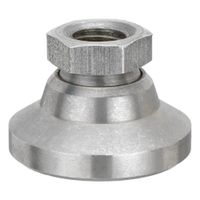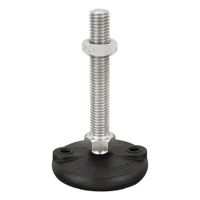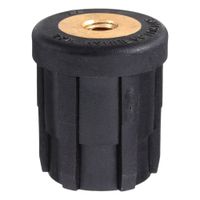Call +(254) 703 030 000 / 751 483 999 / 721 704 777
- Home
- Hardware
- Vibration Control Leveling Mounts
- Leveling Mounts
.....Read More
Frequently Asked Questions
What are leveling mounts used for?
Leveling mounts are devices used to stabilize, support, and adjust the height of machinery, equipment, or furniture to ensure they are level and secure. They are essential in various industries and applications for several reasons:
1. **Stability and Balance**: Leveling mounts help maintain the stability of equipment by compensating for uneven surfaces. This is crucial for machinery that requires precise operation, as an uneven base can lead to operational inefficiencies or damage.
2. **Vibration Damping**: Many leveling mounts are designed with materials or structures that absorb vibrations. This is particularly important in industrial settings where machinery generates significant vibrations that can affect performance and longevity.
3. **Height Adjustment**: They allow for easy height adjustments, ensuring that equipment is at the optimal working level. This is beneficial for ergonomic purposes, reducing strain on workers and improving productivity.
4. **Load Distribution**: Leveling mounts help distribute the weight of the equipment evenly across all points of contact. This prevents excessive stress on any single point, reducing the risk of damage to both the equipment and the surface it rests on.
5. **Protection of Surfaces**: By providing a buffer between the equipment and the floor, leveling mounts protect surfaces from scratches, dents, and other damage that can occur from direct contact.
6. **Ease of Installation and Maintenance**: They simplify the installation process and make it easier to perform maintenance tasks, as equipment can be easily leveled and stabilized without complex procedures.
7. **Versatility**: Available in various sizes, materials, and designs, leveling mounts can be used in diverse environments, from industrial machinery to office furniture, ensuring adaptability to specific needs and conditions.
How do you install male leveling mounts?
1. **Select the Right Mounts**: Choose male leveling mounts suitable for the weight and type of equipment. Ensure the thread size and load capacity match your requirements.
2. **Prepare the Equipment**: Safely lift or tilt the equipment to access the mounting holes. Use appropriate lifting tools to prevent injury or damage.
3. **Clean the Surface**: Ensure the mounting surface is clean and free from debris to allow proper contact and stability.
4. **Insert the Mounts**: Screw the male leveling mounts into the threaded holes on the equipment. If the equipment lacks threaded holes, use a nut and washer on the opposite side to secure the mount.
5. **Adjust the Height**: Rotate the leveling mounts to adjust the height. Use a spirit level to ensure the equipment is level. Adjust each mount incrementally to maintain balance.
6. **Secure the Mounts**: Once leveled, tighten the lock nut against the equipment base to secure the position. This prevents the mounts from loosening due to vibrations.
7. **Check Stability**: Gently rock the equipment to ensure stability. If it wobbles, readjust the mounts as necessary.
8. **Final Inspection**: Double-check all mounts for tightness and ensure the equipment is level and stable.
9. **Lower the Equipment**: Carefully lower the equipment back into position, ensuring it rests evenly on all mounts.
10. **Test the Setup**: Operate the equipment to ensure it functions correctly without excessive vibration or movement.
By following these steps, you can effectively install male leveling mounts to ensure your equipment is stable and level.
What is the difference between male and female leveling mounts?
Male and female leveling mounts differ primarily in their design and method of attachment.
Male leveling mounts feature a threaded stud or bolt that protrudes from the mount. This stud is used to attach the mount to the equipment or machinery by threading it into a corresponding hole or nut on the equipment. The male design is typically used when the equipment has a pre-existing threaded hole or when a nut can be used to secure the mount from the opposite side.
Female leveling mounts, on the other hand, have a threaded hole or socket within the mount itself. This design allows a bolt or threaded rod from the equipment to be inserted into the mount. Female mounts are used when the equipment has a protruding bolt or when the mount needs to be secured by threading a bolt into it.
The choice between male and female leveling mounts depends on the specific application and the design of the equipment being leveled. Male mounts are often preferred for applications where the equipment has a fixed threaded hole, while female mounts are suitable for situations where the equipment has a protruding bolt or when additional flexibility in mounting is required.
Both types of mounts serve the same fundamental purpose: to provide stability, reduce vibration, and allow for height adjustment to ensure that equipment is level and properly aligned. The selection between male and female mounts is typically based on the existing hardware and the specific requirements of the installation.
How do you choose the right leveling mount for machinery?
To choose the right leveling mount for machinery, consider the following factors:
1. **Load Capacity**: Determine the total weight of the machinery and ensure the leveling mount can support it. Consider dynamic loads and safety factors.
2. **Vibration Isolation**: If the machinery generates vibrations, select mounts with vibration-damping capabilities to protect both the equipment and the surrounding environment.
3. **Adjustability**: Ensure the mount offers sufficient height adjustment to level the machinery on uneven surfaces. Check the range of adjustability to match your requirements.
4. **Material**: Choose materials that are compatible with the operating environment. For corrosive environments, stainless steel or coated mounts may be necessary.
5. **Foot Design**: Consider the type of foot design needed, such as swivel, rigid, or anti-slip, based on the floor surface and stability requirements.
6. **Installation and Maintenance**: Opt for mounts that are easy to install and maintain. Consider mounts with self-leveling features for ease of use.
7. **Environmental Conditions**: Assess the operating environment, including temperature, humidity, and exposure to chemicals, to select mounts that can withstand these conditions.
8. **Cost**: Balance the cost with the performance and durability of the mount. Investing in high-quality mounts can reduce maintenance costs and downtime.
9. **Compliance and Standards**: Ensure the mounts meet industry standards and regulations for safety and performance.
10. **Supplier Support**: Choose a reputable supplier who offers technical support and guidance in selecting the appropriate mounts.
By evaluating these factors, you can select the right leveling mount that ensures stability, safety, and longevity of your machinery.
Can leveling mounts reduce noise and vibration?
Yes, leveling mounts can reduce noise and vibration. These mounts are designed to provide stability and support to machinery and equipment, which can help in minimizing the transmission of vibrations and noise. By isolating the equipment from the floor or mounting surface, leveling mounts absorb and dampen vibrations that would otherwise be transmitted through the structure. This isolation is achieved through materials like rubber or elastomers, which have inherent damping properties.
The reduction in vibration not only decreases noise levels but also enhances the longevity and performance of the equipment. Vibrations can lead to mechanical wear and tear, misalignment, and even structural damage over time. By mitigating these vibrations, leveling mounts contribute to a quieter and more stable operational environment.
Additionally, leveling mounts allow for precise adjustment of equipment height and alignment. Proper leveling ensures that the equipment operates as intended, reducing the likelihood of uneven loads and imbalances that can cause additional noise and vibration. This is particularly important in environments where precision and stability are critical, such as in manufacturing or laboratory settings.
In summary, leveling mounts play a crucial role in noise and vibration reduction by isolating equipment from its mounting surface, absorbing vibrations, and allowing for precise leveling and alignment. This not only creates a quieter work environment but also protects the equipment from potential damage caused by excessive vibrations.
How do tube end leveling mounts work?
Tube end leveling mounts are devices used to stabilize and level equipment or furniture that have tubular legs or bases. They consist of a threaded stem, a base or foot, and sometimes a locknut. Here's how they work:
1. **Threaded Stem**: The threaded stem is inserted into the open end of a tube or leg. The threading allows for height adjustment by screwing the stem in or out. This adjustability is crucial for leveling the equipment on uneven surfaces.
2. **Base or Foot**: The base, often made of materials like rubber or plastic, provides a stable contact point with the floor. It is designed to distribute weight evenly and prevent slipping or scratching of the floor surface. Some bases are swivel-mounted to accommodate angled surfaces.
3. **Locknut**: A locknut may be included to secure the position of the threaded stem once the desired height is achieved. This prevents the mount from loosening over time due to vibrations or movement.
4. **Installation**: To install, the threaded stem is inserted into the tube end and adjusted to the required height. The locknut is then tightened to secure the position. The base is placed on the floor, providing stability and leveling.
5. **Functionality**: By adjusting each mount individually, the equipment can be leveled even on uneven surfaces. This is particularly useful for machinery, shelving, or furniture that requires stability for safety and functionality.
Tube end leveling mounts are essential for ensuring that equipment remains stable, reducing wear and tear, and preventing accidents due to imbalance. They are widely used in industrial, commercial, and residential applications.
What materials are leveling mounts typically made from?
Leveling mounts are typically made from a variety of materials, each chosen for specific properties that suit different applications. Common materials include:
1. **Steel**: Often used for its strength and durability, steel leveling mounts are suitable for heavy machinery and industrial applications. They may be coated or plated to resist corrosion.
2. **Stainless Steel**: Known for its corrosion resistance, stainless steel is ideal for environments exposed to moisture, chemicals, or extreme temperatures. It is commonly used in food processing, pharmaceuticals, and outdoor applications.
3. **Aluminum**: Lightweight and resistant to corrosion, aluminum leveling mounts are used where weight is a concern, such as in aerospace or portable equipment.
4. **Plastic**: Materials like nylon or polypropylene are used for lightweight applications where chemical resistance is needed. They are often found in laboratory equipment or electronics.
5. **Rubber**: Often used in combination with metal, rubber provides vibration damping and noise reduction. Rubber leveling mounts are common in HVAC systems and sensitive equipment.
6. **Brass**: Known for its corrosion resistance and aesthetic appeal, brass is used in decorative applications or where electrical conductivity is required.
7. **Zinc**: Often used as a coating for steel to enhance corrosion resistance, zinc-plated mounts are cost-effective for general-purpose applications.
These materials can be combined to optimize performance, such as a steel mount with a rubber base for vibration isolation. The choice of material depends on factors like load capacity, environmental conditions, and specific application requirements.


